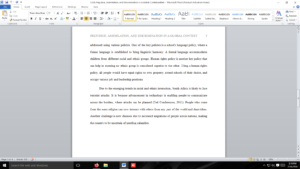American and global perspectives
Required Readings
Marger, M. N. (2015). Race and ethnic relations: American and global perspectives (10th ed.). Stamford, CT: Cengage Learning.
- Chapter 14, “South Africa: Society in Transition” (pp. 393–419)
- Chapter 15, “Brazil: Racial and Ethnic Democracy” (pp. 421–448)
Shah, A. (2010). Racism. Global Issues: Social, Political, Economic and Environmental Issues That Affect Us All. Retrieved from http://www.globalissues.org/
article/165/racism#Rac…
Search through the website for examples of racism throughout the world.
Pew Research Center. (2016a). Global attitudes and trends. Retrieved from http://www.pewglobal.org/
Search the various resources and articles to learn about trends related to immigration, race, and ethnicity.
Use scholarly resources from the Walden Library when researching racial and ethnic experiences in various countries.
Required Media
Ted Conferences (Producer). (2011). Maajid Nawaz: A global culture to fight extremism [Video file]. Retrieved from https://www.ted.com/talks/
maajid_nawaz_a_global_cu…
Note: The approximate length of this media piece is 22 minutes.
“Why do transnational extremist organizations succeed where democratic movements have a harder time taking hold? Maajid Nawaz, a former Islamist extremist, asks for new grassroots stories and global social activism to spread democracy in the face of nationalism and xenophobia.”
Discussion: Prejudice, Assimilation, and Discrimination in a Global Context
The interaction of diverse racial and ethnic groups throughout the world is often associated with a history of prejudice and conflict. Many factors have contributed to the nature of this interaction such as colonialism, modernization, economic competition, labor demands, language, religion, ideology, and national policies. South Africa and Brazil provide contrasting cases studies. Understanding their recent history can be instructive in informing how race and ethnic challenges are addressed in other parts of the world.
In this week’s Discussion, you will analyze the historical background and treatment of racial and ethnic groups within South Africa, Brazil, or a country of your choosing, other than the country where you currently reside.
Note: In Week 3 and Week 4 Discussions, you are required to choose different racial or ethnic groups to analyze (a United States group in Week 3 and a Non-United States group in Week 4). For your Course Project you must use one of the groups you chose in either Week 3 or 4 to be the focus of your analysis.
To prepare:
- Choose South Africa, Brazil, or an alternative choice (excluding Canada).
- Review this week’s Learning Resources.
- Consider the issues related to the group you chose with regard to their experience of prejudice, discrimination, and assimilation.
By Day 3
Post an analysis of the country you chose by addressing the following:
- Identify the country’s major racial or ethnic groups.
- Analyze the historical background and treatment of that country’s racial or ethnic groups, highlighting 2–3 important economic, social, and political forces that have shaped their experiences and/or pivotal events that were key turning points.
- Provide 2–3 examples of discrimination or other social challenges that help shed light on the historical realities of race and ethnic interactions.
- Compare the participation rates, employment levels, and income levels of the major racial or ethnic groups in that country.
- Analyze 1–2 key policies that seek to address racial and ethnic issues.
- Analyze foreseeable challenges this country might face as a result of emerging trends in racial and ethnic interactions.
Return to this Discussion in a few days to read the responses to your initial post.
Grading Criteria
To access your rubric:
Discussion Rubric
Post by Day 3 and Respond by Day 7
To participate in this Discussion:
Week 4 Discussion
Answer preview
The racial and ethnic groups in South Africa were established during the colonial period. Later, the government introduced numerous legislations during the apartheid period, which determined the economic, social, and political experiences of the various ethnic groups. For instance, the whites were the only ones who had the right to access state protection and to vote. Economically, access to official and skilled jobs gave priority to the whites, and they had the right to own means of production. Socially, the blacks were believed to be inferior compared to other groups. Discrimination in South Africa is demonstrated in various ways. For example, whites were given higher quality services compared to blacks. Some hospitals, buses, and beaches were reserved for the whites. Also, there was a separate education system for the blacks to equip them with skills for the laboring class.
[530 Words]
American and global perspectives


